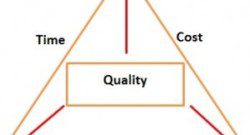Author: Ronald B. Smith, MBA, PMP
Ronald Smith has over four decades of experience as Senior PM/Program Manager. He retired from IBM having written four books and over four dozen articles (for example, PMI’s PM Network magazine and MPUG) on project management, and the systems development life cycle (SDLC). He’s been a member of PMI since 1998 and evaluates articles submitted to PMI’s Knowledge Shelf Library for potential publication. From 2011 - 2017, Ronald had been an Adjunct Professor for a Master of Science in Technology and taught PM courses at the University of Houston’s College of Technology. Teaching from his own book, Project Management Tools and Techniques – A Practical Guide, Ronald offers a perspective on project management that reflects his many years of experience. Lastly in the Houston area, he has started up two Toastmasters clubs and does voluntary work at various food banks.
Killing a Project
Introduction Management reviews, sometimes referred to by project managers as phase exits, stage gates, or kill points, are very important for keeping projects on track. These moments serve as decision point for if a project should be continued, re-assigned, or canceled. Remember that each project is just one part of an entire system an organization has, and changes in other parts of the organization might affect a project’s status. By breaking projects down into phases, management can make sure that their projects are still compatible with the changing needs of the organization. In addition to management reviews, it is important to have management involvement throughout the life cycle of most projects, especially for long-term, large projects. Typically, the executive sponsor or executive steering committee of the project makes the final decision on stopping or killing the venture. Thomas Edison, whose key to success was that he failed often, said of himself, “he could recognize a dead horse before it started to smell.” Unfortunately, in the history of IT, there are too often failing projects (or dead horses) that linger. It’s okay to let a project go if it no longer makes sense! Project cancelation comes from draining cost overruns, schedule overruns, changes in budget, changed or forestalled goals of the project, political factors, rocky project performance, lost stakeholder/user support interest, too many high risks, or any combination of those and other factors. The most common reason for canceling a project is a change in organizational priorities. Sometimes more important projects are just waiting for attention. It’s important to note that contracts often specify the time and way a project may be canceled. Post-Project Review When a project is completed or terminated, there should be a post-project review. Some project managers don’t waste the time performing this review when a project is terminated. I don’t agree with this. Terminated projects are especially important to learn from! Clearly analyze and name the causes that contributed to the premature ending of a project, and remember that pieces (specifically, intellectual property) of the canceled project could possibly be used in the future. Capitalizing on such can help lessen the costly expense of termination. Learn from mistakes made, so that you don’t repeat them again and so you can improve your future projects. Remember, successive recurrences of the same negative situation are not mistakes – they are evidence of neglect. Neglect always carries a high cost and can mean taking fewer profits to the bank. I like to keep in mind the following quote from George Santayana, Spanish-born American philosopher, and humorist, “Those who can’t remember the past are condemned to repeat it.” More Tips When you are getting ready to kill a project, make sure you really can’t save it. As part of a thorough investigation into whether a project must be canceled, review the original scope of work, the skillsets of those involved, the required materials, the testing process, the expectations of the sponsors, and any other factors that contributed to the project reaching a kill point. Don’t play the blame game! Usually, when a project needs to be canceled, several people have made (big) mistakes somewhere along the way. No matter who is to blame, you won’t do yourself any favors by pointing the finger. Hopefully, you work in a positive culture where people are not punished for bringing forth “bad news.” Make sure you communicate the reasons why you had to pull the plug. This is critical because it helps sponsors, employees, and customers all understand that a cancelation doesn’t mean other projects are in jeopardy. If you must cancel multiple projects that are interconnected, try hard not to cause your team stress. Make plans on what to do with the resources that were allocated to the canceled project. For example, employees may be reassigned to other projects and/or pursue additional training. Contractors might have to be let go or reassigned. Any recommendations for changing the development process should be submitted and considered quickly. No process is perfect in its original design, and rapidly changing business needs will continue to challenge the process, so ensure the post-project review receives the necessary attention. I believe project managers in the IT field and in other industries are getting better at identifying “dead horses,” which means we can reduce cost, time overruns, and increase our success rates. Your thoughts in the comment section below are appreciated. This is my fifty MPUG article (or the equivalent of a book), which is a milestone for me. I want to thank the MPUG team and my valuable editor, Jana Phillips, for her outstanding support in making my work straightforward and satisfying.
The Shape of Projects
In this article, I’m referring to IT projects with the ‘shape’ of them being their visible form. Projects, IT projects in particular, come in many different shapes (i.e., plans). The PMBOK (A Guide to the Project Management Body of Knowledge) states that a project is a temporary endeavor undertaken to create a unique product, service, or result. The temporary nature means that a project has a definite beginning and end. The duration can be short, or it can be long, but deliverables likely exist beyond the end of the project and could even last for centuries (for example, the pyramids in Egypt or the Great Wall of China). Projects drive change. Factors that lead to the creation of a Project The following are examples of factors that lead to the creation of a project: New technology Competitive forces Material issues Political changes Market demand Economic changes Customer request Stakeholder demands Legal requirement Business Process Improvements Strategic opportunity Social need Environmental Considerations More Project Attributes A project is developed using ongoing consistent elaboration. Projects are often defined generally when they begin, and as time passes, the specific details of the project’s design and configuration become clearer. Therefore, projects should be developed in increments, so you can identify the effort shaping the design of them. This process defines what the feature does, how it works, and where it fits into existing flows. It includes combining interface ideas with technical possibilities and business priorities. Keep in mind that most IT projects usually require resources from different areas or departments. This includes people, hardware, software, and other types of resources. Projects involve uncertainty because every project is distinctive. It’s sometimes difficult to define appearance clearly, estimate how long something will take to complete, or determine how much it will cost. This uncertainty is one of the main reasons project management is so difficult, especially when new technologies are involved. Every project should have a primary customer or sponsor. The project sponsor usually provides the guidance and financial support for the project. Sponsors for projects should be from senior management in charge of the main parts of the organization impacted by the projects. Project Constraints Every project is constrained in different ways—by scope, time, cost, and quality. To create a successful project, a project manager needs to balance these often-competing goals: Scope Management involves the work effort required to ensure all defined requirements are properly produced and verified. Time Management deals with the mechanics of translating the scope into defined work units/activities required to meet the deliverables. Cost Management refers to the various activities and processes that drive the budget process (for example, resources and/or material costs). The project manager then establishes a control function to guide the project as it progresses. Quality Management is oriented to the customer and is made up of two key parts: quality assurance (QA) and quality control (QC). Whereas QA is process-oriented, QC is product oriented. The goal here is to meet the needs and expectations of the customers by rating progress against certain defined metrics. Other project restraints may include Human Resources management, communications management, risk management, procurement management, and integration management. There are many project management tools and techniques available to assist the manager and their teams in conducting the above constraints or knowledge areas. Development Process Defining the right development process (i.e., Waterfall and/or Agile methodology) for your organization will have a profound impact on controlling the schedule, costs, and quality of a project. The PMBOK is a good starting point for developing/creating the best methodology or model for your organization. An organization should strive to have as few development models as possible. Project members will be most effective and productive using a model that they understand, have experience with, and that everyone can get behind. Familiarity with an acceptable model will aid significantly in the continual successful implementation of that model. Summary Setting project boundaries requires figuring out how much time the raw idea is worth and how the project should be defined. This process gives us the basic boundaries to start shaping what an IT project will look like. Of course, a QA attribute is a measurable or testable property of a system that is used to indicate how well the result satisfies the needs of its stakeholders. Your thoughts on project shapes in the comment section below are appreciated.
When a PM Must Communicate Bad News
Setting the Stage Communication is a fuel that drives project success. In fact, various experts have claimed that communication is the most important skill for a PM. Obviously, this includes how a PM handles the sharing of bad news. Bad news does happen on projects, and how you deliver it can make all the difference on your credibility and possibly your future. Keep in mind, bad news is like trash; the longer you delay taking any action on it, the greater the potential for stink. You should strive not to surprise anyone with bad news, unless you have an action plan to mitigate the problem or alternative solutions to share. You should also have a sensitive approach to revealing bad news, so that the recipients(s) will have greater respect for your thoughtfulness, honesty, and judgment. You might find that you will receive more support when the news is made public. The goal is to put bad news behind you as soon as possible, learn from it, and move on to complete your project. The bottom line—or golden rule—here is never let a problem grow or evolve! When I first discover bad news about my project, I mentally step back and take a big deep breath to look at the big picture and how it will affect my whole project and organization. The problem may not be a concern that is everybody’s worry. For example, if a server is broken, not everyone is interested on what’s going on. However, if a deadline for your project has been moved up, it will affect everyone on the team. The main thing is to understand the degree of the problem. An amusing example of how to lessen bad news (or soften the blow) is provided in the following letter from a college student to her parents. Variations of this letter can be found on many websites. Dear Mom and Dad, or should I say Grandma and Grandpa, Yes, I am pregnant. No, I am not married yet since Larry, my boyfriend, is out of a job. Larry’s employers just don’t seem to appreciate the skills he has learned since he quit high school. Larry looks much younger than you Dad, even though he is three years older. I am quitting college and getting a job so we can get an apartment before the baby is born. I found a beautiful apartment above a 24-hour auto repair garage with good insulation, so the exhaust fumes and noise won’t bother us. I’m very happy. I thought you would be, too. Love, Ashley P.S. There is no Larry. I’m not pregnant or getting married. I’m not quitting school, but I am getting a “D” in Chemistry. I just wanted you to have some perspective. Depending on the bad news you are delivering, you may have an opportunity to put a humorous slant on the situation if you choose to. Humor could cause your audience to be more open to the ideas being presented and show them that not everything needs to be considered a downer. Having a sense of humor helps to create a connection between you and your audience while getting your point across. Using this technique tactfully could help defuse tensions after the news is stated and leave everyone a bit more understanding versus upset. Displaying a sense of humor also helps you to remain cool under pressure and to keep problems in perspective. One quote that comes to mind is this: “It is my belief that you cannot deal with the most serious things in the world unless you understand the most amusing.” -Sir Winston Churchhill Summary A few years ago, I was managing a project for a client and a key player (the Oracle database administrator) resigned, so I had to work in a “frenzy” with Human Resources to get a qualified, full-time replacement ASAP. Fortunately, we found someone and had a smooth transition with little disruption to the project. When I informed the client on what happened and what we’d done about it, it helped to maintain their confidence in our team. Fortunately, the client was not part of our internal “frenzy.” There are several methods that a PM can use in various situations or scenarios when discussing bad news with the client. For example: In some situations, a PM may choose to say nothing about bad news because they quickly took actions to rectify the issue(s). This practice may be useful if a PM is confident that things can be resolved quickly and effectively. Your thoughts in the comment section below are appreciated.
The Quadruple Constraints of Project Management
Most courses and books on project management discuss the “Triple Constraints” in terms of a three-legged stool (see Figure 1 below). The first leg represents Scope Management, the second, Time Management, and the third, Cost Management. If one aspect is shortened or increased in length, then the two other “legs” must be adjusted accordingly for a successful project. For example, if you increase scope, it will influence time and cost. Balancing the triple constraints is a lot like juggling. It’s also a constant reminder of how changing one constraint will cast an impact on the entire project. I have been working in project management for over four decades, and I’ve have observed at least two dozen projects that met the scope, cost, and time goals without being considered successful by the sponsor/customer. Why? There are many factors (resources, communications, procurement, risk, and quality are a few) that can lead to this situation, but most of the time, it was the lack of quality being “baked” into the final service or product. Some people, including myself, believe the triple constraints should be expanded into quadruple constraints, including quality with the aspects of scope, time, and cost. The bottom line is having and meeting quality standards is a key factor in obtaining customer or sponsor satisfaction. It’s likely that this desire for quality was the primary reason why the project was undertaken, in the first place, so why shouldn’t it be just as important as time, scope, and cost?! Quality Management One of the principles of quality management (QM) is that it’s customer oriented. It’s also made up of two key parts: quality assurance (QA) and quality control (QC). QA is the maintenance of a chosen level of quality in a service or product, especially by means of attention to every stage of the process of delivery. The goal here is to meet the needs and expectations of the customers. This all helps to build trust and loyalty. QC involves inspections, reviews, and evaluations of the various units to determine if they are within the specifications for the final product. This is accomplished through independence, integrity, and objectivity. QA is process oriented, whereas QC is product oriented. Projects should have periodic mini reviews that rate progress against certain defined metrics. Table 1 combines the three types of QM reviews (health, compliance, and deliverable) into one mini review. Every project should have prescribed quality indicators that can be used for recovery assessment. This includes the level of defects or number of discrepancies in deliverables–first by internal review, and then by the customer. We also want to look at the number of re-work activities following internal and customer reviews. Monitoring all of this on an ongoing basis is essentially part of tracking and controlling project performance. For software development projects, make sure the end-users or customers are part of the participative development team, so they feel they have ownership of the service or product (this should increase their overall satisfaction). Expect the product requirements to evolve throughout the development process, and continue to validate that the proposed product will be satisfactory to the customer after it is completed and delivered. Summary Always try to see quality through the customer’s eyes, and remember it applies to the life of a product and covers all aspects of a product. I have seen several products introduced that had great quality, but the price was unbelievably high because they had a near monopoly on the marketplace. When the product starts to have competition, prices are lowered and companies look to cutting costs to keep profit margins up. This can result in the product’s quality being reduced. I am speculating a possible example of this is Gillette, which once held a 70% market share in US for razor blades. We’ve seen upstarts like Harry’s and Dollar Shave Club (DSC) slice away at Gillette’s customer base over the last decade. While Gillette remains in control, its market share has shrunk down to nearly 50%. A possible lesson to be learned is that if your product is overpriced and/or you ease up your interest in ensuring quality to save costs, your competitors will gladly demonstrate their interest in winning over your customers. Your thoughts on expanding the triple constraints into the quadruple constraints of project management in the comment section below are appreciated.
Why I Like Being a PM
No. Reason % 1 Incomplete and/or changing requirements 24 2 Lack of user involvement 12 3 Lack of resources 11 4 Unrealistic expectations 10 5 Lack of executive support 9 6 Lack of planning 8 7 Didn’t need any longer 7 8 Lack of IT management 6 9 Technology illiteracy 4 10 Other/miscellaneous 9 Total 100% Source: The Standish Group On top of those discouraging stats, information technology projects have an even higher degree of uncertainty. Here are some reasons why: Technology is changing every 6 – 12 months (new programming languages, new interface mechanisms, hardware platforms, tools, and version compatibility issues). Methodologies are changing for developing products. Resource turnover often runs high. There are no standard benchmarks for ability and skill level of resources. Dependency on the customer for good requirements and project plan task completion runs high. IT is one of the fastest changing business environments. Are you getting the picture? For these reasons and more, it’s difficult being a PM, but these are the same reasons why I like being a PM. In short, I like navigating a learning environment (technology and people) that’s always challenging. I like adding value… I like taking over a troubled project, gaining the confidence of the stakeholders, setting up metrics with a detailed plan, and feeling the satisfaction of turning it around. I like the excitement of a different challenge every time… I never get bored because every project and every day is different. Each project has its own unique personality! For example, if companies A and B are developing an identical application, using the same tools, and have similarly structured organizations, you might assume their project would be nearly identical. Wrong! I guarantee you there will be differences in how they are developed, implemented, and used. Also, it’s possible company A completes the project on time and within budget; whereas company B could go past schedule and eventually cancel the project. Good project management can be effective! I like team communications… Many failed projects are due to breakdown in team communications. To have a clear vision of what your team is doing, you need to setup and implement a communications plan early on. This plan should cover change requests, issues, identifying/investigating other vendors or options, assigning/notifying people that are assigned to your project, executive status meetings, and status “poster-boards” for other people to see. Good communication practices include having weekly tracking/control meetings to identify potential problems and find solutions. These weekly meetings are most important and where the “rubber meets the road.” I like learning new things… There are many different types of learning. This includes formal training, as well as learning new ideas from the projects you are working on, and/or studying lessons learned from current and previous projects. While working in various places and on various assignments throughout my career, I enjoyed learning about the divergent cultures, histories, entertainment, and locality. I also enjoy passing on my knowledge on the job. Read my previous article on mentorship for more on this. I like applying knowledge of human behavior… There’s learning about the different aspects of human behavior, which in turn helps me to understand and improve myself. The following are a few basic lessons about human behavior I learned by meeting and collaborating with numerous clients and co-workers as a PM. By the way, I am still learning. You are what you perceive yourself to be. In other words, your vision of yourself becomes your reality. Honesty is the cornerstone of integrity. Tell the truth no matter how painful it might be, and, overall, your life will be simpler. Integrity is the cornerstone of leadership. Be a role model, obey your rules, and behave like everything you say and do is being observed—it most likely is! Expectations are important. All people need to know the acceptable pattern of behavior that is expected of them on each assignment. Be a good listener, and be willing to admit your shortcomings. When you make a mistake, own up to it, and view it as a learning experience. Go for peace! Admitting when you are wrong can change the mood from one of conflict to that of cooperation. You need to be open to criticism to be able to improve yourself. If someone criticizes you, be open-minded. If you are not sure they are right, get a second…or third opinion. If you know they are wrong, go to the next point. Don’t take things personally. If you constantly do, then you are in the wrong business. To be a good PM, you must get over it and move on! When management have clashes or major differences, it’s usually smart to be neutral. Train yourself to be able to see the big and small picture of your project, but at the same time don’t get too “bogged” down on the details. If you are not an extrovert, you need to become one to be successful in this business. One way of becoming an extrovert is to work on your social awareness. Try to become more socially aware, sympathetic, empathetic, and intuitive about people. The belief that introverts can’t become extroverts is not true. We can change our mode of behavior (read on) if we are serious about it. The best form of communication is interactive. I improved my communication skills (and confidence) by joining Toastmasters International. Another advantage of belonging to Toastmasters or a similar group is that it will help you to think quicker at meetings and improve your writing skills. Speaking of… I like writing… I used to hate writing and usually got D’s on my high school and college English papers. After graduation, I was fortunate that my first job was at Fischer-Price Toys as a Systems Analyst in the applications development area. The unique thing about this experience was that the whole department overdid documentation on every phase of the project. As time progressed, I realized how important writing things up was to the overall project. In the end, I got pretty good at it, and strangely enough, I liked doing it. Since then, I have had four books and dozens of articles published on project management and the systems development life cycle (SDLC). You will do a better job as a PM if you work hard on improving your writing skills. Writing skills are often overlooked as a requirement for PM success, yet I believe someday people will realize how important good writing is when communicating with others. Your thoughts in the comment section below are appreciated.
Back to the Future: What PM Skills Are Called for in 2022 and Beyond?
First…Back to the Past Let’s first travel back in time and look at the state of data processing and information technology (IT) historically. Knowing the past gives us a basis to move forward, and in this article, I’d like to explore what project management (PM) skills are called or in 2022 and beyond. In the early 1960’s, most data processing (DP) systems were stand alone, non-compatible, and located only at major operating units. The applications were mostly in fields of financial reporting. Mass storage devices were widely adopted, but magnetic tape was still the primary medium for storage of data files. By the end of that decade, most systems were becoming stand-alone and compatible. Software was becoming standardized. New applications were in areas of financial control, and the use of data communications was becoming more extensive. Storage devices grew even larger, providing billions of characters of data on-line to the computer. This era saw more extensive decentralization, and the following advantages were realized: Improved effectiveness Less severe economic consequences when failure occurred Less training and bureaucracy Less competition for service Less sophistication needed In the 1970’s, we began to see a concentration of processing power at control sites with terminal access to large control databases. New applications were driven in the areas of order entry and inventory. Following are some of the advantages: Lower overall cost of equipment and systems Fewer personnel problems Fewer support personnel Better DP cost control More sophisticated systems The ability to run large jobs By the late 1970’s, the pendulum was swinging from centralization to distributed DP (DDP)—a cross between centralization and decentralization. With DDP, computer power was decentralized at remote sites to capture and process data at its source. Transmittal of substantial amounts of clean data to a central site became the norm. Therefore, computer power was decentralized, but the control of such was still centralized. The concept of DDP had been around a long time, but it was only possible to achieve with the development of inexpensive mini-computers and cheaper data communication devices. A real DDP system is a network of powerful, self-sufficient satellite systems communicating with each other and/or the host computer. The following are some advantages of DDP: Users have local processing and data storage capability Users have integrated access to other computers Users control their own data Non-competitive access is available This model reduces peak load demands on central computer power Greater responsiveness to user New applications can be quickly supported without costly additions to the central system Lower total system communication costs Less training and bureaucracy The following are seen as disadvantages of DDP: Duplication of input, output, and functions Higher cost due to duplication of hardware, software, data, space, and people Some restrictions on the size and complexity of applications Possible incompatibilities More difficult management and control of operations, standards, development, and databases Limited vendor relations/negotiating power As technology developed through the decades, these challenges began to be teased out. We saw broader uses of DDP elements and redistribution of previously centralized applications. We also eventually saw word processing* and DP people sharing the same workstations, the same communication systems, and the same data files. Some workstations were multi-function units with various work-keys. At a glance, work-keys were used for word processing, source data entry, central computer inquiry, or standalone DP. These multi-function units functioned in workstation clusters and communicated with other dispersed workstations clusters and/or a host computer. Some of the shareable applications included accounts receivable, booklets, marketing surveys, mailing labels, financial reports directories, etc. Output was phototypesetting and telecommunications, for example. Top management within each company mandated the combining of DDP and word processing for the next evolutionary jump into information processing because they realized the economics of sharing equipment, personnel, and data. The sooner advantages were adopted, the sooner a total corporate information system began to unfold. For their projects, project managers used simple analytical tools that included progress flowcharts, decision logic tables, decision trees, Gantt charts, milestone charts, time-space networks, weighted rating, and workflow charts. These tools were easy to grasp and understand because they revolved around some form of hierarchical system. Into the Future As you can see, many of the trends since 1980 have evolved over the last forty years. For example, smaller/faster storage devices and increased use of micro-processors/integrated circuits, which are part of today’s IT foundation/environment. This includes the growth of the internet, cloud computing, digital media, AI applications, and Agile-based projects in this current century. Today, the world’s largest tech companies will largely decide much of what we see and hear in the future. With all this in mind, let’s consider the future of IT and project management, and, more specifically, the job skills PMs will need to evolve into the future! Business Analytics Consultants Business analytics (BA) depended—and still does—on getting substantial amounts of high-quality data to populate across different systems (some of the first were Oracle, IBM, and Azure databases). Deciding what subsets of data adds reporting value to the organization (a.k.a. learning “insights” from past performance, so you can do better business planning) allows PMs to be more competitive. Henry Ford used BA to help plan and build his assembly lines and many companies use it for customer loyalty programs. A current example is Microsoft’s Power BI and other similar ecosystems (Power BI Pro), all of which are really a BA service where end users can create enterprise reports, live dashboards, and rich visualizations versus depending on a IT department. Unless they are trained, most end users won’t have the expertise to work across different systems and will need an experienced Business Analytics Consultant (BAC) to help them accumulate the information or actionable intelligence they need to share and run their business most effectively. This is an area all PMs should consider in future career planning. Strategic Project Managers Strategic Project Managers (SPMs) or Chief Project Officers (CPOs) will soon be breaking the doors down to get into the C-suite of an organization that is driven by information and technology. These people have to know the business, be experienced in project management, be part of the portfolio decision making process, and be innovators and effective communicators. Obviously, a person in the position of SPM or CPO must be a skilled leader, highly respected, and have good relationships with stakeholders! Equally important, this person would be an influential collaborator in defining and helping to deliver the organization’s strategy. The SPM or CPO serves as a crucial interface between the C-suite and the organization in translating the strategy and goals of a project. He/she understands the processes and advantages that need to take place to be successful. Furthermore, this person can help the organization pick the right projects. End-to-End Project Managers The above listed job skills demonstrate where projects transition from the PM to business owner. End-to-End PMs go to the next level and take ownership of a new product or service becoming responsible for providing its benefits. This is happening in China and slowly being embraced by Western countries. A good example of this is the Chinese company called Alibaba Group (NYSE symbol: BABA), which is one of the world’s largest e-commerce, retail, internet, AI, and technology companies. They are considered fast to market, being an Agile-project-based organization and quickly converting ideas into products and services. Their approach a much more innovative and complete way to view project management, in general. Keep in mind an end-to-end PM needs to have effective communication, possess inherent salesmanship skills, and be able to think strategically. Fast-to-market organizations are looking for leaders that have less technical expertise and more end-to-end expertise with strong facilitation skills. These PMs usually possess a stronger business understanding with commercial insights, which should open the door for them moving up to the executive levels of their organizations. To get there, PMs need to get out of their comfort zones, adapt, and step into more leadership roles. At the same time, organizations need to become more flexible overcoming silos and traditional organizational structures, so the work done is project-based! Summary The role of the PM has been shifting away from someone who can tick off tasks as completed on a Gantt chart. 2022+ is bringing us more towards strategic leadership positioning for effecting change in organizations. I see a bright future for PMs and project management because there remains a strong demand for people delivering change! IT is advancing so rapidly, with blockchain and AI, for example, that it’s beginning to outpace the public’s capacity to fully understand its ramifications. Sometimes inventing in the future can cause internal problems for large technology companies. These companies may have to reboot their own culture and/or use project process consultants to update their delivery systems and expand new product lines. Can you foresee the day when a drone taxi will pick me up at my house? Your thoughts in the comment section below are appreciated. *I would like to thank Mona Bertrand for her word processing insight, which was invaluable in the writing of this article.
Late Tasks: Starts and Finishes
The Background Story… I have been a project manager for over forty years. Over that time, I got into the habit of checking my projects for late starts and finishes two or three times a month. This would help me to flag task problems that I needed to research and try to get back on schedule. Originally, I would take my plan and sort the % Complete field which gave me three major groups: 0% (Not Started), 1% – 99% (Started), and 100% (Completed). My initial focus was to drill-down on the first two groups and highlight potential task problems. For the first group (Not Started), I would highlight the tasks that had a start date that was less than or equal to the current date at that time. Keep in mind these late starting tasks could eventually turn in late tasks. For the second group (Started), I would highlight the tasks that had a finish date that was less than or equal to the current date. On large projects, this exercise was time-consuming, and I felt like a kid using a flashlight at night as I drilled-down to find tasks that had late starts and finishes. Highlighting A Better Way Within Microsoft Project, there are multiple ways to find tasks that have late starts and finishes. They include using multiple filters, reports, and/or using a macro. I typically chose to use a simple filter to meet my needs, and Figure 1 below shows a small project plan that I will use to demonstrate my approach using highlighting. Applying a routine filter hides information that does not meet your criteria and applying a highlight (a yellow format) to information that does meet your criteria. Otherwise, the two approaches are nearly identical. When a highlight is applied, the Highlight Filter Applied message appears on the bottom left side of the status bar. To create this new filter, go to the View tab > Data section > Highlight’s drop-down menu > More Highlight Filters > New (Figure 2). To see the result, reference Figure 3. Initially name your filter (e.g., Late Starts and Finishes) and define your filter logic. For the first line, I didn’t use % Complete because it represents the duration that is complete, not the progress that’s been completed on the work. Instead, I used the more accurate % Work Complete ((Actual Work/Work) x 100)) that equals 0% And (logic operator) Start that is less than or equal to “Enter status date:?” (interactive prompt for later) to find the late starts. Next, I used the Or (logic operator) Status that equals Late to find the late finishes. There are four types of Status – Late, Complete, On Schedule, or Future Tasks. When finished, click Save. Then click Highlight from Figure 2. When you select this filter from the Highlight pull-down arrow, the interactive “Enter status date:” dialog box will pop-up (Figure 4) for you to enter the selected date and click OK. This brings you to Figure 5, where you can now see the highlighted late start and finish tasks. You can tell from the % Work Complete column that the task IDs 1 and 6-7 are late finishes (> 0%) and the task IDs 13-14 are late starts (= 0%). Summary Using filters to create your specific information requirements can be extremely helpful. This coupled with using the already built-in filters can up your game as a project manager. Sometimes, you might copy a built-in filter as a foundation for creating your own. Your comments on this topic are appreciated below.
The Influence of a Mentor
Mentoring is the sharing of one’s knowledge, skills, expertise, experience, etc. for the benefit of another. Mentors can play a crucial role in a person’s career. They can offer advice on tasks particular to a job, help someone navigate an organization, and even give general career advice. Mentorship has played an important role in my career. In the early 1970’s, I was an accountant at a family-owned company which was just starting to get into computers and financial systems. Computers really fascinated me, so when a recruiter contacted me about being a financial systems analyst in the IT department of Fisher-Price (now a subsidiary of Mattel), I jumped at the opportunity. At this point in my life, I had never heard of the term Project Manager (PM), and PMI was in its infancy. Looking back, this was the beginning of my long road to becoming a PM at Fisher-Price. Fisher-Prices’ IT department was in overkill mode in every project phase when it came to documentation. Writing was a challenge for me—in high school and college I got mostly C’s on my English papers, and I really needed someone who could help foster these skills. I needed a mentor to help me succeed. I was looking for someone who had experience, expertise, and wisdom—someone who was a good listener and was accessible. Fortunately, in my small group there was a senior systems analyst who had all of those qualities. His name was Art Gunther. Art and I had already started to build a friendly relationship through our weekly team lunches. So, after my first month at Fisher-Price, I asked Art if he would review some of my work (program specifications). Art turned out to be my divine helper, and over time, I began to really trust and respect him. He explained the “ins” and “outs” of projects and the day-to-day tasks of a PM, giving me the foundations to become a strong PM. By exposing me to new and different perspectives, he helped me turn my professional life around, all the while helping me with the writing side of things, too. One piece of advice Art gave that has stayed with me through the years was to “make reading and lifelong learning a part of my routine and part of my life.” I have spent the last forty years building a robust home library, and filled it with IT books that I often reference. During my first year at Fisher-Price, I learned the COBOL language, which I then used when writing my programming specifications. This enabled our programmers to code directly from my specs. Looking back, I don’t know if the programmers thought I was making their job easier or if they were annoyed, as it left little room for creativity. Regardless, after two years of so much writing of documentation, I woke up one morning and realized, I liked doing it and was getting good at it. In fact, I wanted to write and be published, something I soon found out was no easy feat. Since leaving Fisher-Price, I have had the amazing fortune to have four books and over sixty articles (e.g., PMI’s magazine and MPUG) published on project management and the systems development life cycle (SDLC). None of this would have been possible without my first mentor, Art. Later in my career and during the Y2K scare, I was assigned to a large project and became friends with one of the IBMers who was part of the PMO. I soon found out he didn’t understand much about project management or how to use Microsoft Project. Regardless, I liked him, and I wanted him and our project to be successful, I decided to mentor him on project management and how to use Microsoft Project. Looking back, he didn’t seem that interested, he wasn’t really processing the information I was presenting, and didn’t reciprocate in any way. Weeks went by and I realized I had totally wasted my time. Why? He didn’t ask for mentoring because he thought he didn’t need it, and so I learned a lesson: don’t mentor someone that doesn’t acknowledge their need for it or request it. About three years later, I ran into Jim at an airport. We had about an hour to kill between flights, so we sat down to catch up on what we were doing. He told me he regretted that he hadn’t listened to my advice while I was trying to mentor him. He also bemoaned not being able to get a PMP certification. I was stunned. Since then, I have mentored a few co-workers successfully. In turn, I benefited from the satisfaction of helping others and it’s made me a better teacher. Work is not solely about the products you produce, but also about the fulfillment you derive from it. Finding a mentor can enable you to reach your fullest potential as a producer, and becoming a mentor can enable you to help others find that same gratification. Additionally, mentoring has the potential to diminish stress and reduce burnout. It’s important to take time in different ways to support yourself and your mentees. What are your thoughts on mentorship? I’d love to hear from you in the comments below.









